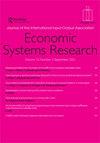基于Eaton–Kortum模型的区域间投入产出分析
IF 1.6
4区 经济学
Q2 ECONOMICS
引用次数: 0
摘要
本研究提出了一个多区域投入产出(I–O)模型,该模型是通过比较静力学分析和Eaton和Kortum(2002)的线性近似获得的。[技术、地理和贸易。计量经济学,70(5),1741–1779。https://doi.org/10.1111/ecta.2002.70.issue-5]一般均衡贸易模型。导出的简化形式代表了最终需求冲击的影响,相当于Leontief逆,这意味着我们的模型是传统I/O框架的直接扩展。此外,在不设定任何结构参数的情况下,还计算了供应侧冲击,如运输成本的下降,以及相应的福利收益。线性归约形式还使我们能够将福利收益分解为各种波纹通道,例如按部门、地区或收益到达的时间。日本的多区域I/O表被用作一个数字示例,以得出运输成本降低的影响(对于北部地区周围的连接)。结果表明,西南地区一半以上的福利收益是通过间接渠道传递的,其到达时间是北部地区的两倍多,接近冲击。本文章由计算机程序翻译,如有差异,请以英文原文为准。
An interregional input–output analysis with the Eaton–Kortum model
This study proposes a multi-regional input–output (I–O) model obtained from comparative statics analysis and a linear approximation of Eaton and Kortum's (2002). [Technology, geography, and trade. Econometrica, 70(5), 1741–1779. https://doi.org/10.1111/ecta.2002.70.issue-5] general equilibrium trade model. The derived reduced form, which represents the effect of a final demand shock, is equivalent to the Leontief inverse, which means that our model is a straightforward extension of the conventional I–O framework. In addition, supply-side shocks, such as a decrease in transport costs, and the corresponding welfare gains are also calculated without setting any structural parameters. The linear reduced forms also enable us to decompose the welfare gains into various ripple channels, such as by sector, region, or the time that the gain arrives. A Japanese multi-regional I–O table is used as a numerical example to derive the effect of a reduction in transport costs (for the links around the northern region). The results indicate that more than half of the welfare gains in the southwest region are delivered through indirect channels, and their time to arrival is more than twice of that in the northern region, which is close to the shock.
求助全文
通过发布文献求助,成功后即可免费获取论文全文。
去求助
来源期刊

Economic Systems Research
ECONOMICS-
CiteScore
5.60
自引率
4.00%
发文量
17
期刊介绍:
Economic Systems Research is a double blind peer-reviewed scientific journal dedicated to the furtherance of theoretical and factual knowledge about economic systems, structures and processes, and their change through time and space, at the subnational, national and international level. The journal contains sensible, matter-of-fact tools and data for modelling, policy analysis, planning and decision making in large economic environments. It promotes understanding in economic thinking and between theoretical schools of East and West, North and South.
 求助内容:
求助内容: 应助结果提醒方式:
应助结果提醒方式:


